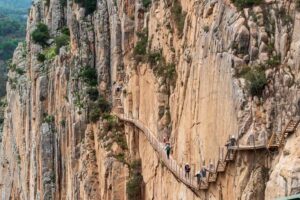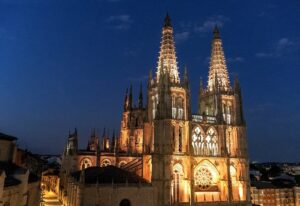Pamplona, the capital of the Kingdom of Navarra, is an urban jewel that combines history, culture and green spaces. This walled city, known for its San Fermín festivals and as a crucial stage on the Camino de Santiago, offers an unforgettable experience for pilgrims and tourists alike.
Stay with us and we will explain all the points of interest and activities that you can do here when you pass through this city on your pilgrimage to Santiago.
Índice de contenidos
Detailed exploration of the old town
We start by talking about one of the main tourist attractions of Pamplona: its old town.
With its tangled labyrinth of narrow streets, it is a window to the medieval past of the city. This carefully preserved historic center is a living canvas of Pamplona’s history, with its buildings dating from the medieval and Renaissance era.

As you walk through these streets, you will come across lively squares that are the scene of daily life for locals and a meeting point for events and festivities. Each building, from old houses to Gothic churches, tells a part of the city.
La Castle plaza, especially, is a place where you can feel the true pulse of Pamplona, with its historic cafes and the vibrant bustle of urban life.
Tourist attractions and historical places
Let’s go on to detail other elements of interest in Pamplona. You will see how this city is one of the most important of all those that you will find along the French Way.
An unforgettable visit to the Cathedral of Santa María
La Cathedral of Santa María, with its impressive neoclassical facade and an interior that is a treasure of Gothic art, is a must-see. From here, we highlight the cloister, the mausoleum of Charles III and the Occidens exhibition, which invites a deep reflection on Western culture. If you are visiting churches and temples along the Camino de Santiago, this is undoubtedly one to take into account.

Citadel of Pamplona: Fortress and Park
La Pamplona Citadel is an exceptional example of the renaissance military architecture. This space, which was once a defensive bastion, has been transformed into a urban oasis of tranquility and culture. The moats and bastions, which once served to protect the city, are now paths for walking and enjoying nature.
The place hosts several cultural events, making it a center of activity throughout the year. Here, history meets the present, offering visitors a place to relax, learn and participate in the cultural life of Pamplona.
Museum of Navarra: A Treasure of Art and History
El Navarra Museum It is a guardian of the artistic and cultural heritage of the region. It houses collections that range from Roman times to the present, so it can be considered a journey through time.
The collection includes Roman architectural remains, Romanesque capitals and medieval sculptures, as well as masterpieces of painting, including portraits of Francisco Goya. The museum is not only a place to admire art, but also to understand the cultural and social evolution of Navarra and its people over the centuries.
What to do in Pamplona
Take a map of the French Camino de Santiago, find Pamplona and sign up for some of the activities you can do to get to know and enjoy this city more:
Explore the walls and fort of St. Bartholomew
The good ones preserved walls of Pamplona They offer a historic walk and panoramic views of the city. He Fort of San Bartolome, with its Interpretation Center, is an excellent starting point to understand the defensive importance of these structures.
San Fermín and El Encierro Route
La San Fermin Route, famous for its bullfighting, is an experience full of history and emotion.

The route begins in the corralillos on the Santo Domingo slope, where the bulls spend the night before the race. The route continues through the heart of the city, passing by the Plaza Consistorial and the iconic Calle Estafeta, where bulls and runners face off in an adrenaline race. At the end of the route, the dangerous alley leads participants to the Bullring.
Parks and gardens: Green oases in the City
Pamplona’s parks and gardens offer a natural counterpoint to the city’s rich urban history.
- The Gardens of the Taconera, with their romantic air, offer a quiet walk among trees and flowers that provide a unique touch.
- El Yamaguchi Park, with its Japanese design, is a tribute to Pamplona’s relationship with its sister city.
- El Arga River Fluvial Park It is an extensive green space ideal for walking, cycling and enjoying nature in an urban environment.
Gastronomy: A Feast for the Senses
Pamplona is a paradise for lovers of good food. The pintxos bars in the Old Town they offer an impressive variety of flavors: from traditional bites to miniature haute cuisine creations. The typical dishes, like chilindrón lamb and Navarrese fried foods They are a sample of the rich culinary tradition of the region.
The Plaza del Castillo and its surroundings are perfect for enjoying a relaxed meal, where the menus combine the best of local gastronomy with Pamplona hospitality.

Tips and advice for pilgrims and visitors
If, as we assume, you decide to do the organized route to Santiago de Compostela, we will give you some tips to make the most of your stay in Pamplona.
- Pamplona Iruña Tourist Card: Use this card to get discounts at museums, guided tours and restaurants.
- Accommodation: Consider spending at least a couple of days in Pamplona to explore everything it has to offer. There are options for all budgets: from luxury hotels to pilgrim hostels.
- Guided tours: Participate in thematic guided tours to discover the history, culture and gastronomy of Pamplona.
- Respect and Openness: Enjoy the cultural diversity of Pamplona with respect and openness.
- Preparation: Wear comfortable clothes and shoes to explore the city on foot and be prepared for changes in weather.
Pamplona is a city that captivates its visitors with its unique mix of history, culture and natural beauty. Regardless of whether you are on a spiritual journey through the the Camino de Santiago or looking for a cultural and gastronomic experience, this city awaits you
with open arms. It promises a stay full of discoveries and unforgettable memories.
With its historic streets, vibrant cultural life and green spaces, Pamplona is a destination that offers something special for every visitor.
Other Jacobean routes
Without a doubt Pamplona is a milestone on the French Way, with its stories and traditions. However, keep in mind any of the other three most popular Jacobean routes:
- With a map of the Camino de Santiago Norte You will be able to see this fantastic route that runs along the Cantabrian coast from West to East
- El trip along the Portuguese way, which starts in Porto, Portugal.
- El Camino de Santiago from Tui, much shorter, which you can cover in about 8 days.
Undoubtedly, whatever the Jacobean routes you choose, it can take you through the most picturesque towns and regions of the entire peninsula. A journey that definitely brings together adventure with spirituality.









